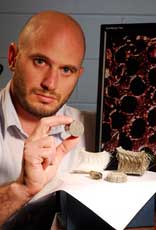Sep 30 2008
Noise from commercial and military jet aircraft causes environmental problems for communities near airports, obliging airplanes to follow often complex noise-abatement procedures on takeoff and landing. It can also make aircraft interiors excessively loud.
 Georgia Tech Research Institute (GTRI) research engineer Jason Nadler has developed a new microchanneled material that reduces aircraft engine noise by wearing it down through a process called viscous shear. Georgia Tech Photo: Gary Meek
Georgia Tech Research Institute (GTRI) research engineer Jason Nadler has developed a new microchanneled material that reduces aircraft engine noise by wearing it down through a process called viscous shear. Georgia Tech Photo: Gary Meek
To address this situation, engineers at the Georgia Tech Research Institute (GTRI) are turning to innovative materials that make possible a new approach to the physics of noise reduction. They have found that honeycomb-like structures composed of many tiny tubes or channels can reduce sound more effectively than conventional methods.
“This approach dissipates acoustic waves by essentially wearing them out,” said Jason Nadler, a GTRI research engineer. “It’s a phenomenological shift, fundamentally different from traditional techniques that absorb sound using a more frequency-dependent resonance.”
The two-year project is sponsored by EADS North America, the U.S. operating entity of EADS.
Most sound-deadening materials – such as foams or other cellular materials comprising many small cavities – exploit the fact that acoustic waves resonate through the air on various frequencies, Nadler explains.
Just as air blowing into a bottle produces resonance at a particular tone, an acoustic wave hitting a cellular surface will resonate in certain-size cavities, thereby dissipating its energy. An automobile muffler, for example, uses a resonance-dependent technique to reduce exhaust noise.
The drawback with these traditional noise-reduction approaches is that they only work with some frequencies – those that can find cavities or other structures in which to resonate.
Nadler’s research involves broadband acoustic absorption, a method of reducing sound that doesn’t depend on frequencies or resonance. In this approach, tiny parallel tubes in porous media such as metal or ceramics create a honeycomb-like structure that traps sound regardless of frequency. Instead of resonating, sound waves plunge into the channels and dissipate through a process called viscous shear.
Viscous shear involves the interaction of a solid with a gas or other fluid. In this case, a gas – sound waves composed of compressed air – contacts a solid, the porous medium, and is weakened by the resulting friction.
“It's the equivalent of propelling a little metal sphere down a rubber hose when the sphere is just a hair bigger than the rubber hose,” Nadler explained. “Eventually the friction and the compressive stresses of contact with the tube would stop the sphere.”
This technique, Nadler adds, is derived from classical mechanical principles governing how porous media interact with gases – such as the air through which sound waves move. Noise abatement using micro-scale honeycomb structures represents a new application of these principles.
“You need to have the hole big enough to let the sound waves in, but you also need enough surface area inside to shear against the wave,” he said. “The result is acoustic waves don’t resonate; they just dissipate.”
In researching this approach, Nadler constructed an early prototype from off-the-shelf capillary tubes, which readily formed a low-density, honeycomb-like structure. Further research showed that the ideal material for broadband acoustic absorption would require micron-scale diameter tubes and a much lower structural density.
Creating such low-density structures presents an interesting challenge, Nadler says. It requires a material that’s light, strong enough to enable the walls between the tubes to be very thin, and yet robust enough to function reliably amid the high-temperature, aggressive environments inside aircraft engines.
Among the likely candidates are superalloys, materials that employ unusual blends of metals to achieve desired qualities such as extreme strength, tolerance of high temperatures and corrosion resistance.
Nadler has developed what could be the world’s first superalloy micro honeycomb using a nickel-base superalloy. At around 30 percent density, the material is very light – a clear advantage for airborne applications – and also very strong and heat resistant.
He estimates this new approach could attenuate aircraft engine noise by up to 30 percent. Micro-honeycomb material could also provide another means to protect the aircraft in critical areas prone to impact from birds or other foreign objects by dissipating the energy of the collision.